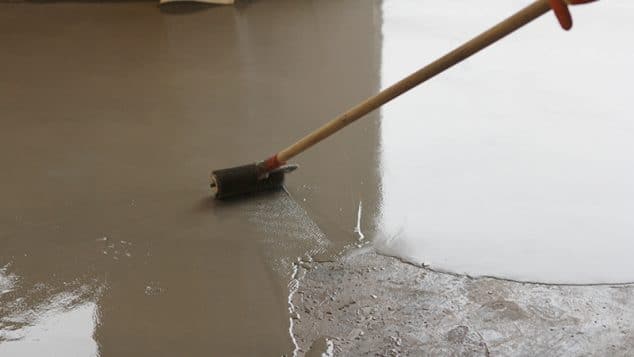Different Types of Screed Installation

Types of Screeds
Types of Screeds. When selecting which type of screed. Use in a project, one of the first things to consider is the system in which the screed is to be laid. By this, we essentially mean. What is the screed going on top of (and, to a lesser extent, what is going on top of the screed?).
This fundamental question will dictate the required thickness of the screed. This will, in turn, help to identify the most appropriate type of screed for a project.
Bonded Screeds
A bonded screed is, simply, a screed that is bonded to a substrate. This would usually be to a concrete slab or such as a beam and block floor. Bonded screeds have the advantage that they can usually be thinner than any other form of screed.
The method for bonding usually requires some form of mechanical preparation of the substrate and to use a “bonding agent”.
These may be as simple as a slurry of cement with water or, more normally with a proprietary bonding agent. On occasion, and particularly where a DPM is also required, the bonding agent may be an epoxy.
Thin Section
The thin section of a bonded screed is the major benefit. But the downside is that any joints in the slab will tend to “reflect” through the surface of the screed. This is particularly an issue with, precast or beam and block substrates. It must be expected that cracking of the screed will occur.
If this is understood and allowed for it is not an issue. A bonded screed is often used as a leveller for a thicker build-up before an insulation. Dry boards are installed and in this situation reflected cracking would be of no consequence.
The minimum thickness of a bonded traditional screed is usually 25mm. But this can be reduced with admixtures or careful selection of the sands used in the mix.
The minimum thickness of flowing gypsum screed is also typically 25mm. But there are now improved versions available that are designed to be laid much thinner. Cement based flowing screeds should normally also be bonded at a minimum of 25mm. But, again, with careful mix design thinner sections are possible.
Unbonded Screed
An unbonded screed is, exactly as its name suggests, one that is not bonded to its substrate. The substrate must be of a noncompressible material, usually concrete and there must be a separating membrane, usually polythene, to ensure that the screed does not bond at all to the substrate and is free to “slide” on it.
Often this type of screed will be specified where there is a need for a DPM between the substrate slab and the screed. Polythene of the correct gauge provides a very low cost damp proof membrane but there is no way for the screed to then be bonded.
In general, the thickness of an unbonded screed will be greater than that necessary for a bonded screed using the same screed material.
Minimum Thickness
The minimum thickness of an unbonded traditional screed will usually be 50mm and this would require the inclusion of some form of reinforcement. In the past, a mild steel welded mesh would have been the norm but more recently the addition of fine fibres (e.g. polypropylene) is more common. The use of proprietary admixtures may also enable slightly thinner sections.
The minimum thickness of an unbonded calcium sulphate screed would normally be 20 or 25mm but recently there have been specifically designed versions of these screeds to enable thickness down to as little as 15mm.
An unbonded cement based flowing screed screed would usually need to be 25mm thick.
It is worth noting that occasionally a specification surfaces for a “partially bonded screed”. This is a screed with no layer installed to debond, it but no measures taken to ensure a good bond. Basically, a screed is laid over a substrate “as is”. This is a poor specification since the screed will tend to bond in places and not in others and this will almost invariably cause cracking at the interfaces between those two conditions. It would be an unusual situation where this level of risk of cracking would be acceptable in order to keep the cost of installation low.
Floating Screeds
In recent years and with the need for most buildings to be much more energy efficient and many residential buildings. To meet specific standards for acoustics it has become very commonplace for screeds to be “floating”.
This simply means that the screed is overlayed on something that is compressible and not rigid. Floating screeds make far greater call on the strength properties of the screed material than screeds placed over solid substrates.
For bonded screeds the only real requirement is for the screed to have adequate strength in compression. This only changes a little for unbonded screeds. When floating, however, it is important that the material exhibits adequate flexural strength.
Traditional sand/cement screeds must, when floating, be installed at a minimum of 75mm thick. Which may be reduced to 65mm for domestic only situations.
The screed will require reinforcement with steel, nylon or fibreglass mesh or, as with unbonded, these may be replaced with fine fibres. It is notoriously difficult to provide the degree of physical compaction needed when trying to lay the screed over a compressible base.
Calcium Sulphate Based Screed
A calcium sulphate based screed will require to be 40mm thick when floating, as will most cement based flowing screeds.
All floating screeds and unbonded screeds have the propensity to “move” slightly independently of the structure. This will happen as the screed cures and dries but also due to thermal expansion and contraction with changing temperature. In all such cases it is necessary to make provision for this movement by the incooporation of compressible materials between the screed edges and fixed point such as perimeter walls, columns etc.
Underfloor Heating
Underfloor heating has been growing in use over recent years and so it is becoming increasingly common for a screed to either contain or overlay an underfloor heating system. This may take the form of electric heating cables or warm water pipework. Almost invariably these screeds will be floating due to the need for there to be a layer of insulation under the heating system. In general, the screed would be installed as any other floating screed but it is likely that the inclusion of the heating system will necessitate a higher thickness. Oftern this will be defined as a minimum “cover” to pipework for example.
Types of Screeds. Underfloor heating systems are where the benefits of flowing screeds become even greater when compared to semi dry screeds. They can be laid thinner at typically 45 to 50mm for calcium sulphate or cement based flowing screeds. Instead of 75mm for traditional screed. The screed will fully encapsulate the pipe. Which is difficult to achieve with hand compacted materials, and the thermal conductivity is much better.
More types of Insulation help and assistance can be found on our FAQ pages or Contact Us page. Follow the links to find the solution to your project.




